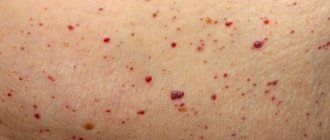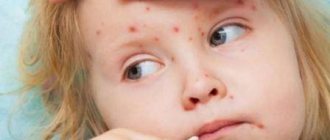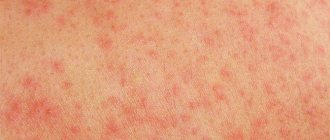Redness on the skin is a very unpleasant phenomenon for both adults and children. As a rule, they cause itching and flaking, which are sometimes accompanied by painful sensations. In addition, in each case, red spots look aesthetically unpleasant and repulsive. It is not surprising that every person strives to get rid of them as quickly as possible. And to do this, first of all, you need to understand the reasons for their occurrence, which can be very different. Moreover, sometimes redness on the skin indicates a very serious disease, including internal organs.
COST OF DERMATOLOGIST SERVICES IN OUR CLINIC IN ST. PETERSBURG
| Dermoscopy price | from 200 rub. |
| Dermatologist appointment | 1000 rub. |
| General blood analysis | from 160 rub. |
| Call free: 8-800-707-1560 *The clinic is licensed to provide urological services | |
What are the most common causes of red spots on the skin?
Allergic reaction
The content of the article
Taking certain medications, as well as consuming a number of vitamins and foods, interacting with pets, getting bacteria or dust mites on the skin, inhaling pollen from flowering plants, etc., can trigger an allergic reaction. Most often, it manifests itself in the appearance of red spots scattered over the body and causing severe itching, which in particularly difficult cases can lead to Quincke's edema and even death.
In such a case, you will need to consult a dermatologist, who will identify the cause of the allergy and prescribe appropriate treatment. Eliminating provoking factors, using histamine blockers and local ointments will allow you to quickly forget about the problem and avoid complications.
Rashes on the hands: the most common diseases
In order to choose the right treatment, it is important to distinguish one type of allergic dermatosis from another. Therefore, let’s look at the symptoms of skin diseases in more detail:
- With atopic dermatitis (neurodermatitis), a rash often appears on the skin of the fingers and hands. The acute period of the disease is characterized by severe itching, redness and swelling of the skin. Itchy spots can come in different shapes and sizes. Without proper treatment, crusts may form at the site of the rash. In the chronic form, symptoms such as dry skin and flaking are observed.[3]
- Urticaria is divided into several types: immunological, physical, drug and idiopathic. The development of the first two is based on the body’s reaction to external stimuli, including food and household allergens, as well as high or low temperatures, sunlight and other factors. Taking certain medications can trigger drug-induced urticaria. Idiopathic is a rash whose cause cannot be determined.[4] All types of hives present more or less the same way: redness, swelling of the skin and the appearance of itchy blisters.
- Contact dermatitis often affects the skin on the fingers, especially when coming into contact with harmful substances such as rubber and metal products, household chemicals, cosmetics and perfumes, topical medications, certain plants and insects.[5] The disease can occur in both acute and chronic forms. The acute course is characterized by redness of the skin and the appearance of itchy blisters. The chronic form is accompanied by dryness and flaking of the skin, increased skin pattern.
- Eczema is an acute and chronic inflammatory disease that affects both the upper and lower extremities. It may also affect various parts of the body. As a rule, eczema rashes are symmetrical, accompanied by redness and limited swelling of the skin. Small blisters filled with clear liquid often appear on affected surfaces.[6]
Presence of an infectious or venereal disease
The “culprit” of red spots is often the viruses of scarlet fever, rubella, measles, chickenpox and other infectious diseases. This also includes the disease syphilis, which manifests itself as red rashes on the skin.
The danger of such diseases is that a person not only experiences discomfort (the appearance of a red rash all over the body in these cases is usually accompanied by fever, chills and other unpleasant symptoms), but also turns into a carrier of the virus. Therefore, at the first signs of an infectious or sexually transmitted disease, accompanied by redness on the skin, you need to consult a doctor and begin comprehensive treatment, including taking antibiotics, antihistamines, vitamins, topical ointments - this is the only way to protect others and quickly cope with the disease.
Red spots
This type is the most common. They have the following features:
- The appearance of spots accompanied by itchy skin may be the result of a dermatological or fungal disease.
- Red spots, which are combined with the development of skin itching and flaking, may be the result of dermatitis, lichen or eczema.
- Small spots with a dark red or crimson tint appear against the background of chickenpox, measles and meningitis. Itching during illness can be unbearable.
- Red spots on healthy skin are the result of allergic reactions.
- Stress exposure is characterized by the appearance of diffuse dark red and burgundy spots in the neck or chest area. Their disappearance is observed after calming down.
Dermatological problems
The most common dermatological disease, characterized by the appearance of red spots - they are located locally or throughout the body - lichen. Experts distinguish several types of lichen, each of which has its own characteristics.
Red flat and ringing, scaly (psoriasis) and shingles, pityriasis and weeping (eczema) - all of them require the mandatory intervention of a specialist who can make a correct diagnosis and timely prescribe therapeutic measures. In addition, some types of lichen are transmitted by contact, which requires isolation of the patient from others, compliance with a special lifestyle, and exclusion of provoking factors.
Pathologies of the cardiovascular system and the consequences of frequent or constant stress and nervous tension.
The human body is a complex system in which everything is interconnected. Therefore, you shouldn’t be surprised if one of the consequences of nervous overstrain is redness of the skin (it’s not for nothing that people came up with the expression: “stains from nerves”). The reason for this phenomenon most often lies in vegetative-vascular dystonia, leading to impaired blood flow.
Redness of the skin will most likely not cause any pain and will go away on its own in a couple of days. However, you need to remember that quite serious diseases of internal organs can also lead to the appearance of spots: the cardiovascular system, gastrointestinal tract, etc. Therefore, any change in the skin should be a reason to contact a skin specialist.
Diseases that most often provoke the appearance of red spots
- Acne . Acne is the most common skin disease in Germany - typical pus-filled pimples and red nodules are found mainly on the face, but also on the back, chest, arms and shoulders.
- Atopic dermatitis . It is a chronic skin condition that is usually characterized by inflamed skin and itching. In addition, the skin is often dry and flaky. The red spots can be patchy and chronic.
- Psoriasis . With psoriasis, red, inflamed plates that are covered with white scales form on the skin. Sometimes the rash can be very itchy.
- Lichen planus . When it develops on the skin or mucous membranes, a large group of reddish, itchy nodules appears. They are especially common on the inside of the wrists or ankles and on the lower legs.
- Rosacea . Characterized by dilated veins and patchy red skin on the face. Redness of the nose, cheeks and forehead may develop into pustules over time.
- Scabies . Scabies is a red, itchy rash caused by a parasite called the scabies mite. Other parasites can also cause the red rash, such as pubic lice, which primarily cause rashes in the armpits, chest, and pubic area.
- Skin fungus . Fungal skin diseases are characterized by slightly red, itchy, scaly areas of the skin. Depending on the type of pathogen, they can settle on a variety of parts of the body, especially often they appear in the folds of the skin.
- Infectious diseases . In addition to skin conditions, infections can cause red spots on the skin. Redness can occur with syphilis, hepatitis, Lyme disease, and Dengue fever.
What will an examination with a dermatologist give?
Since there are a great many causes of skin redness, it is not recommended to “remove” and treat them on your own. And here it doesn’t matter whether we are talking about small rashes scattered throughout or locally located large spots. Flaky and itchy or not causing much concern.
Only an experienced dermatologist will be able to determine the disease, sometimes by the nature and location of the redness. But even in this case, he will definitely prescribe a comprehensive examination, including analysis of scrapings from the affected areas of the skin, which will allow timely clarification of symptoms, the correct selection of treatment therapy, and possibly diagnosis of a very serious disease, which at first glance has nothing to do with the condition of the skin. covers.
If you find an error, please select a piece of text and press Ctrl+Enter
Features of treatment
Treatment of skin diseases of an allergic nature requires an integrated approach. First of all, therapy should be aimed at the absolute exclusion of harmful pathogens, as well as at improving symptoms. Itching, swelling and redness cause patients severe discomfort, both physiological and emotional. Itchy spots make it difficult to sleep and work fully. In addition, the affected areas disrupt the aesthetics of the skin, so patients often hide them under clothing, which can only aggravate the situation. In addition, allergic reactions on the skin cannot be wetted, so patients are deprived of the opportunity to take a bath, visit the pool or sauna.
To eliminate a rash on the hands, it is necessary to use topical external agents in the form of ointments or creams. In the treatment of allergic dermatoses, drugs based on topical glucocorticosteroids have proven themselves to be effective.[10] Such products have wide application possibilities, since they have several effects on the inflammatory focus:
- anti-inflammatory effect;
- antiallergic effect;
- vasoconstrictor properties;
- antipruritic effect.
One of the representatives of local glucocorticosteroids prescribed for the treatment of allergic dermatoses are the drugs "Akriderm GK".
Why are red moles dangerous?
If a red mole does not bother its owner and does not change its external characteristics, it can be argued that such a formation does not pose a significant threat to the health and life of the patient. At the same time, you should get professional medical advice and resort to modern therapeutic methods if you have the following manifestations:
- The red mole grows or changes its shape;
- The patient experiences pain, itching or burning in the area where the pigmented formation is located;
- The mole is bleeding;
- Superficial structures or ulcerations appear;
- There are more than 6 small red dots in one area of the body.
All these symptoms may indicate the development of an oncological process. In addition, the category of dangerous moles includes angiomas located in places where they can be easily injured when wearing clothes, shoes, jewelry, etc. Mechanical damage to such a formation can provoke the appearance of new red moles on the body, activate malignant transformation and leave scars or scars on the skin.
Pigmented papules and plaques on the skin
In some diseases, plaques become dark in color. Such pathologies include:
- basal cell skin cancer (basal cell carcinoma) - a pink or often brown plaque, characterized by slow growth and located on the head or neck;
- melanoma (develops from melanin-synthesizing cells, often birthmarks; spreads quickly and is a malignant neoplasm);
- Becker's nevus (a congenital malformation with a bumpy surface, located in the superficial layer of the skin and characterized by increased pigmentation);
- urticaria pigmentosa (purple-brown spots are diagnosed mainly in children, with a deeper examination they can also be found on internal organs);
- pigmented nevus is a birthmark with smooth and clear boundaries;
- senile keratoma (keratinization of the skin, is benign).
Only after a detailed history collection and laboratory test results can the doctor make a final diagnosis and choose an individual treatment strategy. Methods for treating skin plaques depend on the nature of the pathogen, the type and form of the disease.
Medical correction of red moles
The doctor, after conducting an initial examination and the necessary diagnostic measures, will make a conclusion regarding the likelihood of malignancy of the red mole. Based on this diagnosis, a strategy for further therapeutic actions is developed. If a red mole does not pose an oncological threat and is located in a closed area of the body, its removal is not necessary.
In cases where the red nevus causes aesthetic or physiological discomfort to the patient, it can be removed using modern hardware techniques, the priority among which is laser destruction. This method of removing red moles guarantees painlessness and safety for the patient, and also has a low level of trauma.
Medical offers its patients the latest expert-class medical equipment that meets the most stringent European standards. Effective therapy, high-quality medical service and affordable prices are the main principles of our clinic.
Find out the cost of the procedure “Removal of tumors”










